In the CDS we treat the most vulnerable people from babies to the elderly. All our patients are extraordinarily unique, so we need a service where we have the ability to spend more time with patients and be really flexible with them. Depending on the situation presented I may need to sit on the floor with children in order to look in their mouths, carry out check-ups in the waiting room or whilst patients are sitting in a car. Dentists also have the option to use a room that looks less clinical for patients who require this; as long as it meets confidentiality requirements. We try to build a level of trust and rapport with the goal of the patient agreeing to come into surgery with us the next time and eventually being able to sit on the dental chair.
In the CDS we can also provide home visits when necessary, or plan to have longer appointments as needed in clinic as often our patients require more time. Some of our patients may benefit from having a tooth extracted in a hospital instead of at our clinic, and if needed we can liaise with teams at the hospital so that they can attend beforehand to get used to the environment. I often tell children they are going to have a tooth “wobbled out” so it sounds slightly more pleasant and they don’t feel so anxious about the procedure.
A varied patient group with huge vulnerabilities
Our patients may be medically compromised, have learning disabilities, anxious, or bariatric. As a result of these comorbidities, it can be hard for them to access care in a timely manner.
It is often not only the fact that a patient has learning difficulties, but that many of our patients are also taking lots of medications. If this is the case, we then have to consider drug interactions, how these medications will affect their dental treatment as well as, in many instances, having a dry mouth as a result of taking multiple medications. Having a dry mouth can increase the risk of having tooth decay, so all of these many factors can combine and lead to further issues with a lot of our patients. These complexities mean we often have to liaise with health professionals in other departments to agree the best course of treatment.
Some of the children we see in the Community Dental Service are on Child in Need Plans or Child Protection Plans, this is when children have identified by local authorities as requiring extra support relating to their care, often they have social workers appointed to them throughout this process. Many of these children require quick and direct access to care. As part of my role, I often see children who may have just been taken into foster care who, sometimes at their first appointment have no real bond with their new carers, and may be frightened and lost. Then, after treating them over weeks and months, we see them become closer to that foster parent, happier and more confident children overall. It is one of the best parts of my job.
Waiting lists and their effect on patients
The service is bursting at the seams more than ever. At the moment we are playing catch up and there are huge volumes of patients that are in desperate need of dental treatment. Some of our patients need to be seen every three months, but this is just not possible. On top of this, there are huge pressures to see new patients, which is an arbitrary measure of success for our service as by seeing more new patients, we inevitably fall behind on seeing our routine patients; many of whom we cannot discharge to general dental services if, for example, they have severe learning disabilities.
It is a really upsetting situation to be in, as CDS dentists are so passionate about their jobs and our patients, so it’s really hard seeing our core patients being overdue for check-ups or treatment by six months to a year. This patient group are often medically compromised or have learning disabilities, and they frequently require a lot of dentistry. We want to keep our core patients at the heart of everything we do.
For some patients who are referred into our service, they can be facing waits of up to a year or more to be seen, this can be different depending on where you live in the country. Then sometimes when patients are eventually accepted into our service, if they require treatment in hospitals they may then need to join another waiting list to access care.
"We cannot focus solely on downstream solutions."
New ways to tackle prevention rather than cure
We cannot focus solely on downstream solutions. At the moment we have a huge risk of staff burnout and dedicated dentists leaving community dental services, so I want to see long term engagement with staff, more dentists on the ground, and collaboration between dentistry and other health institutions and services.
Supervised tooth brushing schemes in nurseries and schools and giving routine advice to new parents regarding diet and brushing are examples of how we can impact oral health from the beginning of life.
All children need access to toothbrushes, toothpaste and fluoridated water. Many years ago, Community Dental Services had funding to be able to go into schools and complete screenings of children, which enabled dental professionals to see lots of children at once and recognise early signs of dental decay. Following this, parents were sent letters home to advise them that their children need to visit a dentist, this is no longer a service that many Community Dental Services can provide, and is now often left to dental charities. Another group of patients that we care for include the elderly, for these patients, we need to ensure that care home staff know how to look after patients' teeth, this may include brushing teeth and denture care as many of these patients are not able to maintain their own oral health.
As a society we need to consider whole body health; after all, the common risk factors for dental decay are the same as those for common health conditions, including high sugar consumption, tobacco use, alcohol use and poor oral hygiene, as well as underlying social and commercial determinants of health. That is why I strongly feel prevention needs to be at the heart of general dentistry, and especially the Community Dental Service.


